Women’s Apparel Market
Women's Apparel Market Size and Share Forecast Outlook 2025 to 2035
The women's apparel market is projected to grow from USD 770.0 billion in 2025 to USD 1,044.9 billion by 2035, at a CAGR of 3.1%. Tops/Dresses will dominate with a 38.0% market share, while specialty/fast fashion will lead the distribution channel segment with a 44.0% share.
Women's Apparel Market Forecast and Outlook 2025 to 2035
The global women's apparel market is projected to reach USD 1,050.0 billion by 2035, recording an absolute increase of USD 280.0 billion over the forecast period. The market is valued at USD 770.0 billion in 2025 and is set to rise at a CAGR of 3.1% during the assessment period. The overall market size is expected to grow by nearly 1.4 times during the same period, supported by increasing female workforce participation and rising disposable income worldwide, driving demand for versatile wardrobe options and growing adoption of fast fashion and e-commerce platforms globally. However, sustainability concerns and economic pressures affecting consumer spending may pose challenges to market expansion.
Quick Stats for Women's Apparel Market
- Women's Apparel Market Value (2025): USD 770.0 billion
- Women's Apparel Market Forecast Value (2035): USD 1,050.0 billion
- Women's Apparel Market Forecast CAGR: 3.1%
- Leading Category Type in Women's Apparel Market: Tops/Dresses
- Key Growth Regions in Women's Apparel Market: Asia-Pacific, North America, and Europe
- Top Key Players in Women's Apparel Market: Inditex, H&M, Fast Retailing, Shein, Lululemon, Nike, Adidas, PVH, Gap, Next
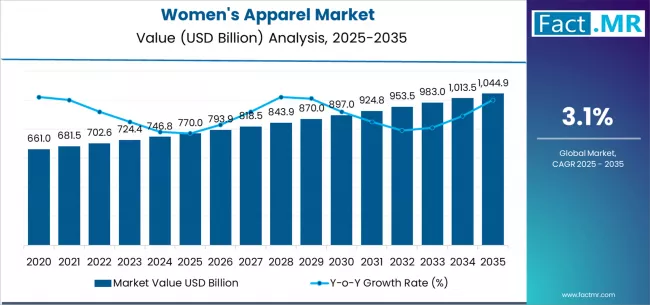
Between 2025 and 2030, the women's apparel market is projected to expand from USD 770.0 billion to USD 903.0 billion, resulting in a value increase of USD 133.0 billion, which represents 47.5% of the total forecast growth for the decade. This phase of development will be shaped by rising female workforce participation and fashion consciousness, product innovation in athleisure and sustainable fashion and digital-first retail strategies, as well as expanding integration with e-commerce platforms and social media marketing. Companies are establishing competitive positions through investment in fast fashion capabilities, omnichannel retail experiences, and strategic market expansion across online, specialty, and department store channels.
From 2030 to 2035, the market is forecast to grow from USD 903.0 billion to USD 1,050.0 billion, adding another USD 147.0 billion, which constitutes 52.5% of the overall ten-year expansion. This period is expected to be characterized by the expansion of sustainable and ethical fashion options, including circular fashion initiatives and eco-friendly materials tailored for environmentally conscious consumers, strategic collaborations between fashion brands and sustainability organizations, and an enhanced focus on personalization and inclusive sizing. The growing emphasis on sustainable fashion and digital innovation will drive demand for comprehensive apparel solutions across diverse lifestyle, professional, and leisure applications.
Women's Apparel Market Key Takeaways
| Metric | Value |
|---|---|
| Market Value (2025) | USD 770.0 billion |
| Market Forecast Value (2035) | USD 1,050.0 billion |
| Forecast CAGR (2025-2035) | 3.1% |
Why is the Women's Apparel Market Growing?
The women's apparel market grows by enabling women across diverse demographics and lifestyles to access fashionable clothing and wardrobe solutions that meet evolving professional, social, and personal expression needs without compromising style, comfort, or affordability.
Fashion-conscious consumers and working women face increasing demands for versatile wardrobes that support career advancement, social engagement, and lifestyle activities, with modern women's apparel typically providing style versatility, comfort technology, and trend accessibility that traditional clothing options cannot match, making contemporary fashion essential for personal expression and professional success positioning. The fashion industry's need for rapid trend cycles and diverse consumer segments creates demand for comprehensive apparel solutions that can provide style innovation, size inclusivity, and price accessibility without compromising quality or fashion relevance.
Government initiatives promoting women's economic empowerment and workplace equality drive adoption in developing regions where female workforce participation directly impacts clothing demand and fashion consumption patterns. However, economic uncertainties affecting consumer spending and sustainability concerns regarding fast fashion may limit premium product adoption among price-sensitive consumers and environmentally conscious market segments.
Segmental Analysis
The market is segmented by category, distribution channel, price tier, and region. By category, the market is divided into tops/dresses, bottoms, intimates/loungewear, and others. Based on distribution channel, the market is categorized into specialty/fast fashion, online, department stores/others. By price tier, the market includes mass, premium, luxury. Regionally, the market is divided into Asia-Pacific, North America, Europe, and other key regions.
By Category, the Tops/Dresses Segment Accounts for a Dominant Market Share
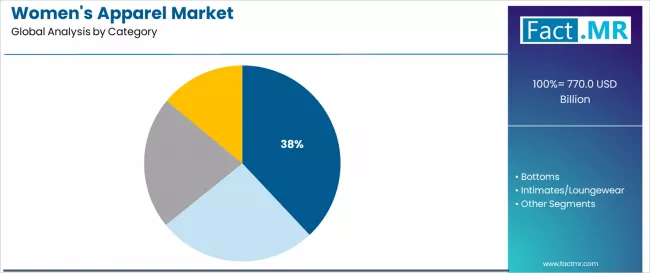
The tops/dresses segment represents the dominant force in the women's apparel market, capturing approximately 38.0% of total market share in 2025. This established category encompasses versatile upper garments and dress options featuring diverse styling options, seasonal adaptability, and professional-to-casual versatility that enable comprehensive wardrobe building and style expression across all fashion demographics. The tops/dresses segment's market leadership stems from its superior wardrobe versatility capabilities, with products capable of serving multiple occasions while maintaining style relevance and comfort requirements across all lifestyle and professional environments.
The bottoms segment maintains a substantial 31.0% market share, serving comprehensive wardrobe needs with pants, skirts, and specialized bottom wear that provide foundational wardrobe pieces for professional, casual, and active lifestyle requirements. These products offer essential wardrobe staples for daily wear while providing sufficient style variety to meet diverse fashion preferences and occasion demands. The intimates/loungewear segment accounts for approximately 31.0% of the market, serving comfort and foundation garment needs with growing emphasis on athleisure and home comfort applications.
Key category advantages driving the tops/dresses segment include:
- Versatile styling options with seasonal adaptability that provide maximum wardrobe flexibility and occasion-appropriate dressing solutions
- Professional-to-casual compatibility enabling seamless transition between work environments and social activities without wardrobe changes
- Trend responsiveness options allowing rapid incorporation of fashion trends and seasonal styles across diverse consumer preferences
- Style expression features, supporting personal brand development and individual fashion identity across professional and social contexts
By Distribution Channel, the Specialty/Fast Fashion Segment Accounts for the Largest Market Share
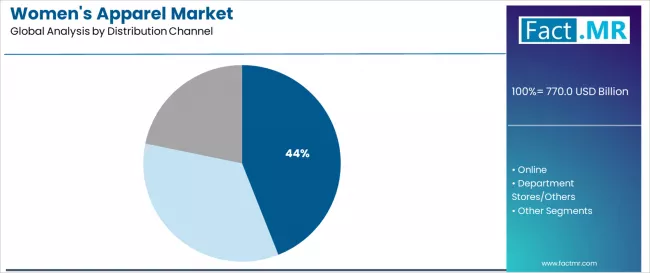
Specialty/fast fashion retail channels dominate the women's apparel market with approximately 44.0% market share in 2025, reflecting the consumer preference for trend-focused retailers and dedicated fashion specialists that provide rapid style turnover, affordable pricing, and comprehensive fashion merchandising across global retail markets. The specialty/fast fashion segment's market leadership is reinforced by consumer demand for current trends, frequent new arrivals, and accessible pricing that drives shopping frequency and wardrobe refresh cycles.
The online segment represents the rapidly growing second-largest distribution channel, capturing 37.0% market share through e-commerce platforms, direct-to-consumer brands, and digital-first retailers that leverage convenience, selection variety, and personalized shopping experiences. This segment benefits from changing shopping behaviors that prioritize convenience, comparison shopping, and access to global fashion brands and emerging designers.
The department stores/others segment accounts for 19.0% market share, serving traditional retail experiences through established department stores, boutiques, and specialty retailers. This segment demonstrates transformation through enhanced experiential retail, personal styling services, and omnichannel integration.
Key market dynamics supporting distribution growth include:
- Specialty/fast fashion expansion driven by trend-conscious consumers and rapid fashion cycle demands across global retail markets
- Online retail acceleration enabling convenient shopping experiences with global brand access and personalized recommendations
- Department store evolution creating premium shopping experiences with personal styling services and brand curation
- Growing emphasis on omnichannel retail driving demand for seamless shopping experiences across physical and digital touchpoints
What are the Drivers, Restraints, and Key Trends of the Women's Apparel Market?
The market is driven by three concrete demand factors tied to women's empowerment and lifestyle evolution outcomes. First, female workforce participation growth and professional advancement create expanding demand for versatile professional wardrobes, with women's career advancement growing by 4-6% annually in major developed economies worldwide, requiring comprehensive professional fashion infrastructure. Second, social media influence and fashion consciousness drive increased clothing consumption and trend adoption, with many women prioritizing style expression and fashion currency for personal and professional branding by 2030. Third, athleisure and lifestyle diversification trends enable expanded casual and active wear applications that support work-life integration while maintaining style and comfort standards.
Market restraints include economic pressures affecting discretionary spending that can reduce fashion consumption, particularly during inflationary periods when household budgets prioritize essential expenditures. Sustainability concerns regarding fast fashion environmental impact pose another significant challenge, as consumers increasingly question clothing waste, manufacturing practices, and environmental responsibility, potentially affecting purchase frequency. Supply chain complexities and labor cost pressures create additional operational challenges, demanding ongoing investment in ethical manufacturing and supply chain transparency.
Key trends indicate accelerated growth in sustainable and ethical fashion options, particularly among younger consumers who prioritize environmental responsibility and social impact in purchasing decisions. Technology integration trends toward personalized styling with AI recommendations, virtual fitting technologies, and sustainable material innovations enable enhanced consumer experiences that meet evolving expectations for convenience, customization, and environmental responsibility. However, the market thesis could face disruption if economic recession significantly reduces discretionary spending or sustainability requirements fundamentally alter fast fashion business models.
Analysis of the Women's Apparel Market by Key Country
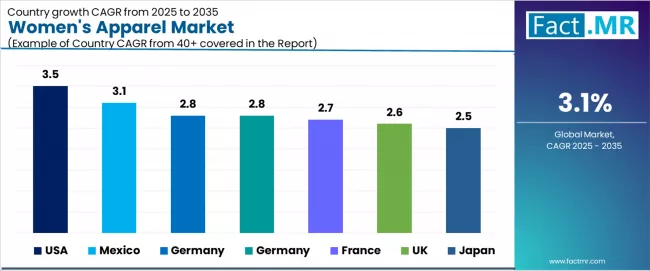
| Country | CAGR (2025-2035) |
|---|---|
| USA | 3.5% |
| Mexico | 3.1% |
| Germany | 2.8% |
| South Korea | 2.8% |
| France | 2.7% |
| UK | 2.6% |
| Japan | 2.5% |
The women's apparel market is gaining momentum worldwide, with the USA taking the lead thanks to strong consumer spending power and established fashion retail infrastructure. Close behind, Mexico benefits from growing female workforce participation and expanding middle-class fashion consumption, positioning itself as a strategic growth hub in the Latin American region. Germany and South Korea show equal advancement, where integration of fashion technology and sustainable fashion trends strengthen their roles in the European and Asian fashion supply chains. France demonstrates steady growth, focusing on luxury fashion heritage and premium market positioning, while the UK emphasizes fashion innovation and emerging designer support. Meanwhile, Japan continues to record consistent progress in fashion sophistication and style innovation. Together, the USA and Mexico anchor the global expansion story, while the rest build stability and diversity into the market's growth path.
The report covers an in-depth analysis of 40+ countries; 7 top-performing countries are highlighted below.
USA Leads Global Market Expansion
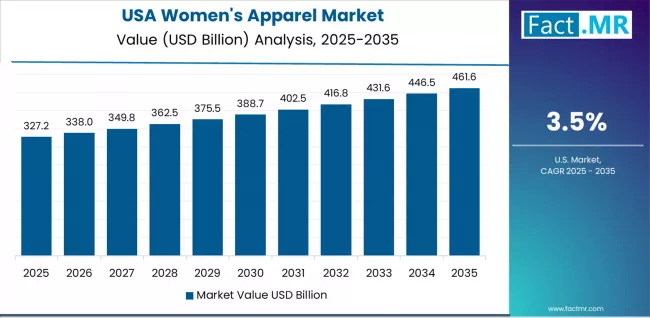
The USA demonstrates the strongest growth potential in the Women's Apparel Market with a CAGR of 3.5% through 2035. The country's leadership position stems from robust consumer spending power, established fashion retail infrastructure, and strong female workforce participation driving the adoption of diverse wardrobe solutions and fashion innovation across professional, casual, and active wear segments. Growth is concentrated in major metropolitan areas, including New York, Los Angeles, Chicago, and Miami, where fashion-conscious consumers and professional women are implementing comprehensive wardrobe strategies and trend adoption for enhanced personal and professional positioning. Distribution channels through major fashion retailers and e-commerce platforms expand coverage across diverse demographic segments and lifestyle preferences throughout the country. The country's emphasis on individual expression and professional advancement provides sustained demand for fashion innovation, including sustainable options and size-inclusive ranges.
Key market factors:
-
Fashion retail expansion concentrated in metropolitan areas and suburban markets with comprehensive omnichannel retail infrastructure development programs
- Professional advancement culture through established female workforce participation and career-focused fashion consumption patterns
- Comprehensive fashion ecosystem, including established retailers and emerging direct-to-consumer brands
- Innovation leadership featuring sustainable fashion initiatives, size inclusivity programs, and advanced fashion technology capabilities
Mexico Emerges as High-Growth Market
In Mexico City, Guadalajara, Monterrey, and expanding urban centers, the adoption of comprehensive women's apparel is accelerating across growing middle-class demographics and increasing female workforce participation, driven by economic development and changing social roles. The market demonstrates strong growth momentum with a CAGR of 3.1% through 2035, linked to comprehensive urbanization and increasing focus on professional development and fashion consciousness among Mexican women. Mexican consumers are implementing fashion-forward wardrobes and professional styling to support career advancement while expressing cultural and personal identity in expanding professional environments. The country's demographic advantages and economic growth create sustained demand for fashion products, while increasing emphasis on women's empowerment drives adoption of diverse wardrobe solutions.
- Leading urban centers, including Mexico City, Guadalajara, and Monterrey, are driving women's apparel adoption
- Economic empowerment models enabling female workforce expansion and professional fashion consumption
- Social transformation trends accelerating adoption with changing gender roles and professional advancement
- Demographic advantages through young population growth and increasing female economic participation
Germany Maintains Fashion Innovation Leadership
Germany's established fashion retail and sustainable fashion sector demonstrates sophisticated implementation of women's apparel solutions, with documented case studies showing 18% increase in sustainable fashion adoption through eco-conscious retailers and ethical fashion brands. The country's fashion infrastructure in major cities, including Berlin, Munich, Hamburg, and Frankfurt, showcases integration of traditional German quality standards with modern sustainable fashion technologies, leveraging expertise in ethical manufacturing and environmental responsibility. German consumers emphasize quality, sustainability, and ethical production, creating demand for certified sustainable fashion products that support environmental goals and social responsibility. The market maintains steady growth through focus on sustainable fashion innovation and quality standards, with a CAGR of 2.8% through 2035.
Key development areas:
- Sustainable fashion retailers and ethical brands leading eco-conscious apparel adoption with comprehensive environmental programs
- Quality-focused channels providing integrated solutions with 87% sustainable material certification rates
- Innovation partnerships between German fashion companies and sustainable textile producers expanding responsible market reach
- Integration of traditional German quality craftsmanship and modern sustainable fashion responsibility practices
Europe Market Split by Country
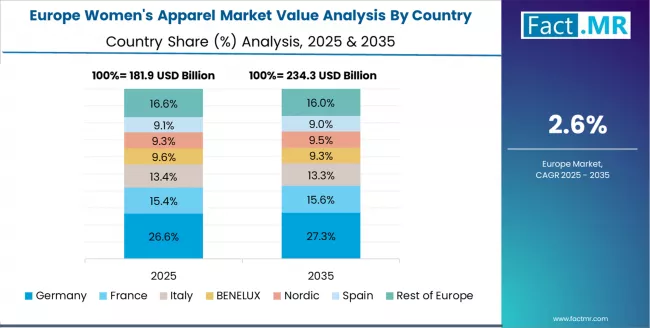
The women's apparel market in Europe is projected to grow from USD 192.5 billion in 2025 to USD 262.5 billion by 2035, registering a CAGR of 3.1% over the forecast period. Germany is expected to maintain its leadership position with a 22.1% market share in 2025, declining slightly to 21.9% by 2035, supported by its strong fashion retail infrastructure, established quality fashion culture, and comprehensive sustainable fashion distribution networks serving major European markets.
France follows with a 20.8% share in 2025, projected to reach 20.9% by 2035, driven by comprehensive luxury fashion heritage programs in Paris, Lyon, and other metropolitan areas implementing advanced fashion retail experiences. The United Kingdom holds a 18.7% share in 2025, expected to maintain 18.5% by 2035 through the ongoing development of fashion innovation and emerging designer support. Italy commands a 16.9% share, while Spain accounts for 13.2% in 2025. The Rest of Europe region is anticipated to gain momentum, expanding its collective share from 8.3% to 9.2% by 2035, attributed to increasing women's apparel adoption in Nordic countries and emerging Eastern European fashion markets implementing modern retail standards.
Competitive Landscape of the Women's Apparel Market
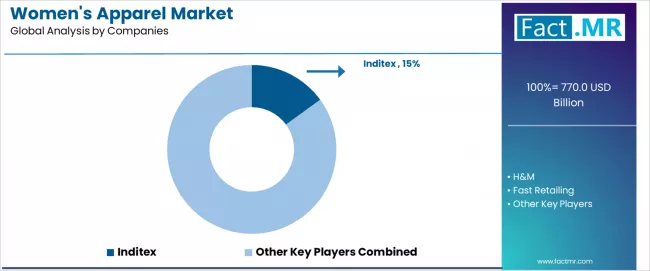
The Women's Apparel Market features approximately 50-60 meaningful players with moderate concentration, where the top three companies control roughly 8-12% of global market share through established global retail networks and diverse brand portfolios. Competition centers on trend responsiveness, price accessibility, and omnichannel presence rather than market dominance alone.
Market leaders include Inditex, H&M, and Fast Retailing, which maintain competitive advantages through comprehensive fashion retail portfolios, global supply chain networks, and deep expertise in fast fashion operations and trend translation, creating strong consumer loyalty and retail efficiency capabilities. These companies leverage established global retail networks and ongoing digital transformation investments to defend market positions while expanding into adjacent fashion categories and sustainable fashion segments.
Challengers encompass Shein and Lululemon, which compete through specialized digital-first strategies and niche market focus respectively, demonstrating strong presence in key demographic segments. Global fashion and lifestyle specialists, including Nike, Adidas, and PVH, focus on specific categories or premium positioning, offering differentiated capabilities in athletic wear, luxury fashion, and brand heritage.
Regional players and emerging direct-to-consumer brands create competitive pressure through digital innovation and niche positioning, particularly in high-growth markets including Asia-Pacific where e-commerce growth and changing consumer preferences provide advantages in digital engagement and trend responsiveness. Market dynamics favor companies that combine global scale with local market understanding and comprehensive omnichannel capabilities that address the complete fashion consumer journey from trend discovery through purchase and style expression.
Global Women's Apparel Market - Stakeholder Contribution Framework
Women's apparel solutions represent a critical lifestyle category that enables women across diverse demographics and professional environments to access fashionable clothing and wardrobe options without compromising personal expression, professional requirements, or budget constraints, typically providing style versatility, trend accessibility, and size inclusivity that traditional fashion offerings cannot match across diverse lifestyle needs. With the market projected to grow from USD 770.0 billion in 2025 to USD 1,050.0 billion by 2035 at a 3.1% CAGR, these solutions offer compelling advantages - style diversity, affordability, and accessibility - making them essential for professional wardrobe building, casual lifestyle expression, and special occasion dressing across diverse consumer segments. Scaling market penetration and sustainability practices requires coordinated action across fashion industry policy, ethical manufacturing standards, apparel manufacturers, retail partners, and sustainability advocacy organizations.
How Governments Could Spur Local Production and Adoption?
- Women's Economic Empowerment Programs: Include fashion industry development in national economic empowerment initiatives, providing targeted support for women-owned fashion businesses and supporting female workforce participation through professional wardrobe development financing and skills training grants.
- Trade Policy & Manufacturing Support: Implement favorable treatment for ethical fashion manufacturing, provide incentives for companies investing in sustainable production and fair labor practices, and establish manufacturing standards that encourage domestic apparel production over exploitative manufacturing alternatives.
- Regulatory Framework Development: Create standardized ethical manufacturing processes across fashion and textile industries, establish clear labor rights frameworks for international trade, and develop transparency protocols that facilitate responsible fashion commerce.
- Skills Development & Training: Fund fashion design and manufacturing education programs, sustainable textile technology training, and ethical business practice development. Invest in vocational programs that bridge traditional textile skills with modern sustainable fashion design and responsible manufacturing standards.
- Market Access & Labor Policy: Establish procurement policies that support ethical fashion manufacturing for government applications, assist women-owned fashion businesses through preferential lending programs, and create regulatory environments that encourage innovation in sustainable fashion while protecting worker rights.
How Industry Bodies Could Support Market Development?
- Ethical Standards & Certification: Define standardized sustainability metrics for fashion across retail and manufacturing operations, establish universal labor rights and environmental protocols, and create certification programs for ethical fashion practices that consumers and advocates can trust.
- Market Education & Best Practices: Lead messaging that demonstrates sustainable fashion advantages, emphasizing ethical production, environmental responsibility, and superior long-term value compared to fast fashion alternatives.
- Sustainability Integration Standards: Develop interoperability standards for ethical certification, sustainable material guidelines, and circular fashion platforms, ensuring seamless integration across different fashion applications and international ethical markets.
- Professional Development: Run certification programs for fashion professionals, sustainability specialists, and ethical business experts on optimizing sustainable fashion applications, social responsibility verification, and ethical manufacturing practices in competitive fashion markets.
How Manufacturers and Technology Players Could Strengthen the Ecosystem?
- Advanced Manufacturing Development: Develop next-generation fashion production methods with enhanced sustainability capabilities, improved labor conditions, and responsible manufacturing features that maintain cost-effectiveness while enabling superior environmental performance and worker welfare.
- Innovation Platforms: Provide comprehensive supply chain systems that integrate blockchain verification, ethical manufacturer partnerships, sustainability monitoring, and social responsibility assurance, enabling fashion brands to maximize sourcing transparency and ethical authenticity.
- Service & Support Networks: Offer flexible support programs for fashion brands and retailers, including sustainability verification options, ethical consultation services, and social responsibility guidance that keep fashion products current with consumer values and ethical expectations.
- Research & Development Networks: Build comprehensive R&D capabilities, collaborative sustainability programs, and ethical fashion systems that ensure fashion technologies maintain superior style innovation and consistent social responsibility across diverse market segments and consumer preferences.
How Suppliers Could Navigate the Shift?
- Diversified Category Portfolios: Expand women's apparel offerings across tops/dresses (38.0% market dominance), bottoms (31.0% share), and intimates/loungewear applications, with particular focus on specialty/fast fashion channels (44.0% channel share) and sustainable positioning strategies.
- Geographic Market Development: Establish operations in high-growth markets like USA (3.5% CAGR) and Mexico (3.1% CAGR), while strengthening presence in established markets like Germany (2.8% CAGR) and South Korea (2.8% CAGR) through regional partnerships and local fashion understanding.
- Technology-Enabled Services: Implement advanced customer engagement systems with personalization capabilities, sustainability reporting, and omnichannel integration that differentiate service offerings and improve consumer satisfaction and brand loyalty.
- Flexible Price Models: Develop mass, premium, and luxury fashion solutions that accommodate varying consumer needs, from cost-effective everyday wear to ultra-premium designer products for demanding fashion requirements.
How Investors and Financial Enablers Could Unlock Value?
- Fashion Innovation Financing: Provide growth capital for established companies like Inditex, H&M, and Fast Retailing to expand sustainable fashion capabilities and omnichannel presence, particularly in emerging markets with growing female workforce participation.
- Innovation Investment: Back startups developing advanced sustainable fashion technologies, circular fashion platforms, and ethical manufacturing systems that enhance fashion industry innovation and competitive positioning.
- Regional Market Development: Finance market entry and expansion strategies for fashion companies establishing operations in high-growth regions, supporting local manufacturing partnerships that enhance ethical sourcing while maintaining cost competitiveness.
- Consolidation & Scale Opportunities: Support strategic acquisitions and market consolidation that create economies of scale, improve sustainability capabilities, and enhance competitive positioning against fragmented regional fashion providers across multiple geographic markets.
Key Players in the Women's Apparel Market
- Inditex
- H&M
- Fast Retailing
- Shein
- Lululemon
- Nike
- Adidas
- PVH
- Gap
- Next
Scope of the Report
| Item | Value |
|---|---|
| Quantitative Units | USD 770.0 Billion |
| Category | Tops/Dresses, Bottoms, Intimates/Loungewear, Others |
| Distribution Channel | Specialty/Fast Fashion, Online, Department Stores/Others |
| Price Tier | Mass, Premium, Luxury |
| Regions Covered | Asia-Pacific, North America, Europe, Latin America, Middle East & Africa |
| Country Covered | USA, Mexico, Germany, South Korea, France, UK, Japan, and 40+ countries |
| Key Companies Profiled | Inditex, H&M, Fast Retailing, Shein, Lululemon, Nike, Adidas, PVH, Gap, Next |
| Additional Attributes | Dollar sales by category and distribution channel segments, regional adoption trends across Asia-Pacific, North America, and Europe, competitive landscape with fashion retailers and brand partners, consumer behavior patterns and fashion preferences, integration with sustainability initiatives and ethical fashion programs, innovations in fashion technology and omnichannel retail systems, and development of specialized applications with size inclusivity and sustainable positioning. |
Women's Apparel Market by Segments
-
Category :
- Tops/Dresses
- Bottoms
- Intimates/Loungewear
- Others
-
Distribution Channel :
- Specialty/Fast Fashion
- Online
- Department Stores/Others
-
Price Tier :
- Mass
- Premium
- Luxury
-
Region :
- Asia-Pacific
- China
- Japan
- South Korea
- India
- Australia & New Zealand
- ASEAN
- Rest of Asia Pacific
- North America
- United States
- Canada
- Mexico
- Europe
- Germany
- United Kingdom
- France
- Italy
- Spain
- Nordic
- BENELUX
- Rest of Europe
- Latin America
- Brazil
- Chile
- Rest of Latin America
- Middle East & Africa
- Kingdom of Saudi Arabia
- Other GCC Countries
- Turkey
- South Africa
- Other African Union
- Rest of Middle East & Africa
- Asia-Pacific
Table of Content
- Executive Summary
- Global Market Outlook
- Demand to side Trends
- Supply to side Trends
- Technology Roadmap Analysis
- Analysis and Recommendations
- Market Overview
- Market Coverage / Taxonomy
- Market Definition / Scope / Limitations
- Market Background
- Market Dynamics
- Drivers
- Restraints
- Opportunity
- Trends
- Scenario Forecast
- Demand in Optimistic Scenario
- Demand in Likely Scenario
- Demand in Conservative Scenario
- Opportunity Map Analysis
- Product Life Cycle Analysis
- Supply Chain Analysis
- Investment Feasibility Matrix
- Value Chain Analysis
- PESTLE and Porter’s Analysis
- Regulatory Landscape
- Regional Parent Market Outlook
- Production and Consumption Statistics
- Import and Export Statistics
- Market Dynamics
- Global Market Analysis 2020 to 2024 and Forecast, 2025 to 2035
- Historical Market Size Value (USD Million) Analysis, 2020 to 2024
- Current and Future Market Size Value (USD Million) Projections, 2025 to 2035
- Y to o to Y Growth Trend Analysis
- Absolute $ Opportunity Analysis
- Global Market Pricing Analysis 2020 to 2024 and Forecast 2025 to 2035
- Global Market Analysis 2020 to 2024 and Forecast 2025 to 2035, By Category
- Introduction / Key Findings
- Historical Market Size Value (USD Million) Analysis By Category , 2020 to 2024
- Current and Future Market Size Value (USD Million) Analysis and Forecast By Category , 2025 to 2035
- Tops/Dresses
- Bottoms
- Intimates/Loungewear
- Others
- Y to o to Y Growth Trend Analysis By Category , 2020 to 2024
- Absolute $ Opportunity Analysis By Category , 2025 to 2035
- Global Market Analysis 2020 to 2024 and Forecast 2025 to 2035, By Distribution Channel
- Introduction / Key Findings
- Historical Market Size Value (USD Million) Analysis By Distribution Channel, 2020 to 2024
- Current and Future Market Size Value (USD Million) Analysis and Forecast By Distribution Channel, 2025 to 2035
- Specialty/Fast Fashion
- Online
- Department Stores/Others
- Y to o to Y Growth Trend Analysis By Distribution Channel, 2020 to 2024
- Absolute $ Opportunity Analysis By Distribution Channel, 2025 to 2035
- Global Market Analysis 2020 to 2024 and Forecast 2025 to 2035, By Region
- Introduction
- Historical Market Size Value (USD Million) Analysis By Region, 2020 to 2024
- Current Market Size Value (USD Million) Analysis and Forecast By Region, 2025 to 2035
- North America
- Latin America
- Western Europe
- Eastern Europe
- East Asia
- South Asia and Pacific
- Middle East & Africa
- Market Attractiveness Analysis By Region
- North America Market Analysis 2020 to 2024 and Forecast 2025 to 2035, By Country
- Historical Market Size Value (USD Million) Trend Analysis By Market Taxonomy, 2020 to 2024
- Market Size Value (USD Million) Forecast By Market Taxonomy, 2025 to 2035
- By Country
- USA
- Canada
- Mexico
- By Category
- By Distribution Channel
- By Country
- Market Attractiveness Analysis
- By Country
- By Category
- By Distribution Channel
- Key Takeaways
- Latin America Market Analysis 2020 to 2024 and Forecast 2025 to 2035, By Country
- Historical Market Size Value (USD Million) Trend Analysis By Market Taxonomy, 2020 to 2024
- Market Size Value (USD Million) Forecast By Market Taxonomy, 2025 to 2035
- By Country
- Brazil
- Chile
- Rest of Latin America
- By Category
- By Distribution Channel
- By Country
- Market Attractiveness Analysis
- By Country
- By Category
- By Distribution Channel
- Key Takeaways
- Western Europe Market Analysis 2020 to 2024 and Forecast 2025 to 2035, By Country
- Historical Market Size Value (USD Million) Trend Analysis By Market Taxonomy, 2020 to 2024
- Market Size Value (USD Million) Forecast By Market Taxonomy, 2025 to 2035
- By Country
- Germany
- UK
- Italy
- Spain
- France
- Nordic
- BENELUX
- Rest of Western Europe
- By Category
- By Distribution Channel
- By Country
- Market Attractiveness Analysis
- By Country
- By Category
- By Distribution Channel
- Key Takeaways
- Eastern Europe Market Analysis 2020 to 2024 and Forecast 2025 to 2035, By Country
- Historical Market Size Value (USD Million) Trend Analysis By Market Taxonomy, 2020 to 2024
- Market Size Value (USD Million) Forecast By Market Taxonomy, 2025 to 2035
- By Country
- Russia
- Poland
- Hungary
- Balkan & Baltic
- Rest of Eastern Europe
- By Category
- By Distribution Channel
- By Country
- Market Attractiveness Analysis
- By Country
- By Category
- By Distribution Channel
- Key Takeaways
- East Asia Market Analysis 2020 to 2024 and Forecast 2025 to 2035, By Country
- Historical Market Size Value (USD Million) Trend Analysis By Market Taxonomy, 2020 to 2024
- Market Size Value (USD Million) Forecast By Market Taxonomy, 2025 to 2035
- By Country
- China
- Japan
- South Korea
- By Category
- By Distribution Channel
- By Country
- Market Attractiveness Analysis
- By Country
- By Category
- By Distribution Channel
- Key Takeaways
- South Asia and Pacific Market Analysis 2020 to 2024 and Forecast 2025 to 2035, By Country
- Historical Market Size Value (USD Million) Trend Analysis By Market Taxonomy, 2020 to 2024
- Market Size Value (USD Million) Forecast By Market Taxonomy, 2025 to 2035
- By Country
- India
- ASEAN
- Australia & New Zealand
- Rest of South Asia and Pacific
- By Category
- By Distribution Channel
- By Country
- Market Attractiveness Analysis
- By Country
- By Category
- By Distribution Channel
- Key Takeaways
- Middle East & Africa Market Analysis 2020 to 2024 and Forecast 2025 to 2035, By Country
- Historical Market Size Value (USD Million) Trend Analysis By Market Taxonomy, 2020 to 2024
- Market Size Value (USD Million) Forecast By Market Taxonomy, 2025 to 2035
- By Country
- Kingdom of Saudi Arabia
- Other GCC Countries
- Turkiye
- South Africa
- Other African Union
- Rest of Middle East & Africa
- By Category
- By Distribution Channel
- By Country
- Market Attractiveness Analysis
- By Country
- By Category
- By Distribution Channel
- Key Takeaways
- Key Countries Market Analysis
- USA
- Pricing Analysis
- Market Share Analysis, 2024
- By Category
- By Distribution Channel
- Canada
- Pricing Analysis
- Market Share Analysis, 2024
- By Category
- By Distribution Channel
- Mexico
- Pricing Analysis
- Market Share Analysis, 2024
- By Category
- By Distribution Channel
- Brazil
- Pricing Analysis
- Market Share Analysis, 2024
- By Category
- By Distribution Channel
- Chile
- Pricing Analysis
- Market Share Analysis, 2024
- By Category
- By Distribution Channel
- Germany
- Pricing Analysis
- Market Share Analysis, 2024
- By Category
- By Distribution Channel
- UK
- Pricing Analysis
- Market Share Analysis, 2024
- By Category
- By Distribution Channel
- Italy
- Pricing Analysis
- Market Share Analysis, 2024
- By Category
- By Distribution Channel
- Spain
- Pricing Analysis
- Market Share Analysis, 2024
- By Category
- By Distribution Channel
- France
- Pricing Analysis
- Market Share Analysis, 2024
- By Category
- By Distribution Channel
- India
- Pricing Analysis
- Market Share Analysis, 2024
- By Category
- By Distribution Channel
- ASEAN
- Pricing Analysis
- Market Share Analysis, 2024
- By Category
- By Distribution Channel
- Australia & New Zealand
- Pricing Analysis
- Market Share Analysis, 2024
- By Category
- By Distribution Channel
- China
- Pricing Analysis
- Market Share Analysis, 2024
- By Category
- By Distribution Channel
- Japan
- Pricing Analysis
- Market Share Analysis, 2024
- By Category
- By Distribution Channel
- South Korea
- Pricing Analysis
- Market Share Analysis, 2024
- By Category
- By Distribution Channel
- Russia
- Pricing Analysis
- Market Share Analysis, 2024
- By Category
- By Distribution Channel
- Poland
- Pricing Analysis
- Market Share Analysis, 2024
- By Category
- By Distribution Channel
- Hungary
- Pricing Analysis
- Market Share Analysis, 2024
- By Category
- By Distribution Channel
- Kingdom of Saudi Arabia
- Pricing Analysis
- Market Share Analysis, 2024
- By Category
- By Distribution Channel
- Turkiye
- Pricing Analysis
- Market Share Analysis, 2024
- By Category
- By Distribution Channel
- South Africa
- Pricing Analysis
- Market Share Analysis, 2024
- By Category
- By Distribution Channel
- USA
- Market Structure Analysis
- Competition Dashboard
- Competition Benchmarking
- Market Share Analysis of Top Players
- By Regional
- By Category
- By Distribution Channel
- Competition Analysis
- Competition Deep Dive
- Inditex
- Overview
- Product Portfolio
- Profitability by Market Segments (Product/Age /Sales Channel/Region)
- Sales Footprint
- Strategy Overview
- Marketing Strategy
- Product Strategy
- Channel Strategy
- H&M
- Fast Retailing
- Shein
- Lululemon
- Nike
- Adidas
- PVH
- Gap
- Next
- Inditex
- Competition Deep Dive
- Assumptions & Acronyms Used
- Research Methodology
List Of Table
- Table 1: Global Market Value (USD Million) Forecast by Region, 2020 to 2035
- Table 2: Global Market Value (USD Million) Forecast by Category , 2020 to 2035
- Table 3: Global Market Value (USD Million) Forecast by Distribution Channel, 2020 to 2035
- Table 4: North America Market Value (USD Million) Forecast by Country, 2020 to 2035
- Table 5: North America Market Value (USD Million) Forecast by Category , 2020 to 2035
- Table 6: North America Market Value (USD Million) Forecast by Distribution Channel, 2020 to 2035
- Table 7: Latin America Market Value (USD Million) Forecast by Country, 2020 to 2035
- Table 8: Latin America Market Value (USD Million) Forecast by Category , 2020 to 2035
- Table 9: Latin America Market Value (USD Million) Forecast by Distribution Channel, 2020 to 2035
- Table 10: Western Europe Market Value (USD Million) Forecast by Country, 2020 to 2035
- Table 11: Western Europe Market Value (USD Million) Forecast by Category , 2020 to 2035
- Table 12: Western Europe Market Value (USD Million) Forecast by Distribution Channel, 2020 to 2035
- Table 13: Eastern Europe Market Value (USD Million) Forecast by Country, 2020 to 2035
- Table 14: Eastern Europe Market Value (USD Million) Forecast by Category , 2020 to 2035
- Table 15: Eastern Europe Market Value (USD Million) Forecast by Distribution Channel, 2020 to 2035
- Table 16: East Asia Market Value (USD Million) Forecast by Country, 2020 to 2035
- Table 17: East Asia Market Value (USD Million) Forecast by Category , 2020 to 2035
- Table 18: East Asia Market Value (USD Million) Forecast by Distribution Channel, 2020 to 2035
- Table 19: South Asia and Pacific Market Value (USD Million) Forecast by Country, 2020 to 2035
- Table 20: South Asia and Pacific Market Value (USD Million) Forecast by Category , 2020 to 2035
- Table 21: South Asia and Pacific Market Value (USD Million) Forecast by Distribution Channel, 2020 to 2035
- Table 22: Middle East & Africa Market Value (USD Million) Forecast by Country, 2020 to 2035
- Table 23: Middle East & Africa Market Value (USD Million) Forecast by Category , 2020 to 2035
- Table 24: Middle East & Africa Market Value (USD Million) Forecast by Distribution Channel, 2020 to 2035
List Of Figures
- Figure 1: Global Market Pricing Analysis
- Figure 2: Global Market Value (USD Million) Forecast 2020-2035
- Figure 3: Global Market Value Share and BPS Analysis by Category , 2025 and 2035
- Figure 4: Global Market Y to o to Y Growth Comparison by Category , 2025-2035
- Figure 5: Global Market Attractiveness Analysis by Category
- Figure 6: Global Market Value Share and BPS Analysis by Distribution Channel, 2025 and 2035
- Figure 7: Global Market Y to o to Y Growth Comparison by Distribution Channel, 2025-2035
- Figure 8: Global Market Attractiveness Analysis by Distribution Channel
- Figure 9: Global Market Value (USD Million) Share and BPS Analysis by Region, 2025 and 2035
- Figure 10: Global Market Y to o to Y Growth Comparison by Region, 2025-2035
- Figure 11: Global Market Attractiveness Analysis by Region
- Figure 12: North America Market Incremental Dollar Opportunity, 2025-2035
- Figure 13: Latin America Market Incremental Dollar Opportunity, 2025-2035
- Figure 14: Western Europe Market Incremental Dollar Opportunity, 2025-2035
- Figure 15: Eastern Europe Market Incremental Dollar Opportunity, 2025-2035
- Figure 16: East Asia Market Incremental Dollar Opportunity, 2025-2035
- Figure 17: South Asia and Pacific Market Incremental Dollar Opportunity, 2025-2035
- Figure 18: Middle East & Africa Market Incremental Dollar Opportunity, 2025-2035
- Figure 19: North America Market Value Share and BPS Analysis by Country, 2025 and 2035
- Figure 20: North America Market Value Share and BPS Analysis by Category , 2025 and 2035
- Figure 21: North America Market Y to o to Y Growth Comparison by Category , 2025-2035
- Figure 22: North America Market Attractiveness Analysis by Category
- Figure 23: North America Market Value Share and BPS Analysis by Distribution Channel, 2025 and 2035
- Figure 24: North America Market Y to o to Y Growth Comparison by Distribution Channel, 2025-2035
- Figure 25: North America Market Attractiveness Analysis by Distribution Channel
- Figure 26: Latin America Market Value Share and BPS Analysis by Country, 2025 and 2035
- Figure 27: Latin America Market Value Share and BPS Analysis by Category , 2025 and 2035
- Figure 28: Latin America Market Y to o to Y Growth Comparison by Category , 2025-2035
- Figure 29: Latin America Market Attractiveness Analysis by Category
- Figure 30: Latin America Market Value Share and BPS Analysis by Distribution Channel, 2025 and 2035
- Figure 31: Latin America Market Y to o to Y Growth Comparison by Distribution Channel, 2025-2035
- Figure 32: Latin America Market Attractiveness Analysis by Distribution Channel
- Figure 33: Western Europe Market Value Share and BPS Analysis by Country, 2025 and 2035
- Figure 34: Western Europe Market Value Share and BPS Analysis by Category , 2025 and 2035
- Figure 35: Western Europe Market Y to o to Y Growth Comparison by Category , 2025-2035
- Figure 36: Western Europe Market Attractiveness Analysis by Category
- Figure 37: Western Europe Market Value Share and BPS Analysis by Distribution Channel, 2025 and 2035
- Figure 38: Western Europe Market Y to o to Y Growth Comparison by Distribution Channel, 2025-2035
- Figure 39: Western Europe Market Attractiveness Analysis by Distribution Channel
- Figure 40: Eastern Europe Market Value Share and BPS Analysis by Country, 2025 and 2035
- Figure 41: Eastern Europe Market Value Share and BPS Analysis by Category , 2025 and 2035
- Figure 42: Eastern Europe Market Y to o to Y Growth Comparison by Category , 2025-2035
- Figure 43: Eastern Europe Market Attractiveness Analysis by Category
- Figure 44: Eastern Europe Market Value Share and BPS Analysis by Distribution Channel, 2025 and 2035
- Figure 45: Eastern Europe Market Y to o to Y Growth Comparison by Distribution Channel, 2025-2035
- Figure 46: Eastern Europe Market Attractiveness Analysis by Distribution Channel
- Figure 47: East Asia Market Value Share and BPS Analysis by Country, 2025 and 2035
- Figure 48: East Asia Market Value Share and BPS Analysis by Category , 2025 and 2035
- Figure 49: East Asia Market Y to o to Y Growth Comparison by Category , 2025-2035
- Figure 50: East Asia Market Attractiveness Analysis by Category
- Figure 51: East Asia Market Value Share and BPS Analysis by Distribution Channel, 2025 and 2035
- Figure 52: East Asia Market Y to o to Y Growth Comparison by Distribution Channel, 2025-2035
- Figure 53: East Asia Market Attractiveness Analysis by Distribution Channel
- Figure 54: South Asia and Pacific Market Value Share and BPS Analysis by Country, 2025 and 2035
- Figure 55: South Asia and Pacific Market Value Share and BPS Analysis by Category , 2025 and 2035
- Figure 56: South Asia and Pacific Market Y to o to Y Growth Comparison by Category , 2025-2035
- Figure 57: South Asia and Pacific Market Attractiveness Analysis by Category
- Figure 58: South Asia and Pacific Market Value Share and BPS Analysis by Distribution Channel, 2025 and 2035
- Figure 59: South Asia and Pacific Market Y to o to Y Growth Comparison by Distribution Channel, 2025-2035
- Figure 60: South Asia and Pacific Market Attractiveness Analysis by Distribution Channel
- Figure 61: Middle East & Africa Market Value Share and BPS Analysis by Country, 2025 and 2035
- Figure 62: Middle East & Africa Market Value Share and BPS Analysis by Category , 2025 and 2035
- Figure 63: Middle East & Africa Market Y to o to Y Growth Comparison by Category , 2025-2035
- Figure 64: Middle East & Africa Market Attractiveness Analysis by Category
- Figure 65: Middle East & Africa Market Value Share and BPS Analysis by Distribution Channel, 2025 and 2035
- Figure 66: Middle East & Africa Market Y to o to Y Growth Comparison by Distribution Channel, 2025-2035
- Figure 67: Middle East & Africa Market Attractiveness Analysis by Distribution Channel
- Figure 68: Global Market - Tier Structure Analysis
- Figure 69: Global Market - Company Share Analysis
- FAQs -
How big is the women's apparel market in 2025?
The global women's apparel market is estimated to be valued at USD 770.0 billion in 2025.
What will be the size of women's apparel market in 2035?
The market size for the women's apparel market is projected to reach USD 1,044.9 billion by 2035.
How much will be the women's apparel market growth between 2025 and 2035?
The women's apparel market is expected to grow at a 3.1% CAGR between 2025 and 2035.
What are the key product types in the women's apparel market?
The key product types in women's apparel market are tops/dresses, bottoms, intimates/loungewear and others.
Which distribution channel segment to contribute significant share in the women's apparel market in 2025?
In terms of distribution channel, specialty/fast fashion segment to command 44.0% share in the women's apparel market in 2025.